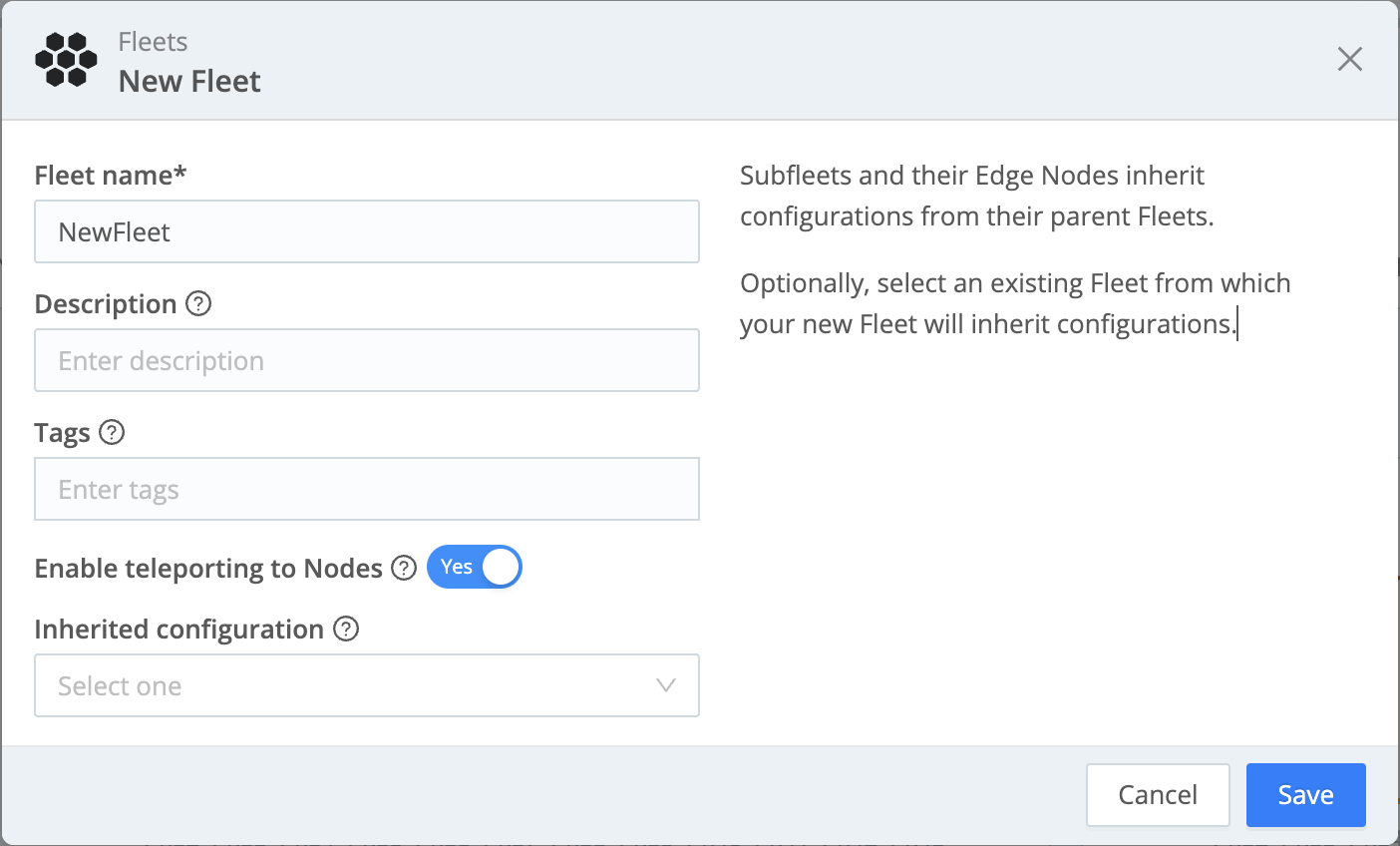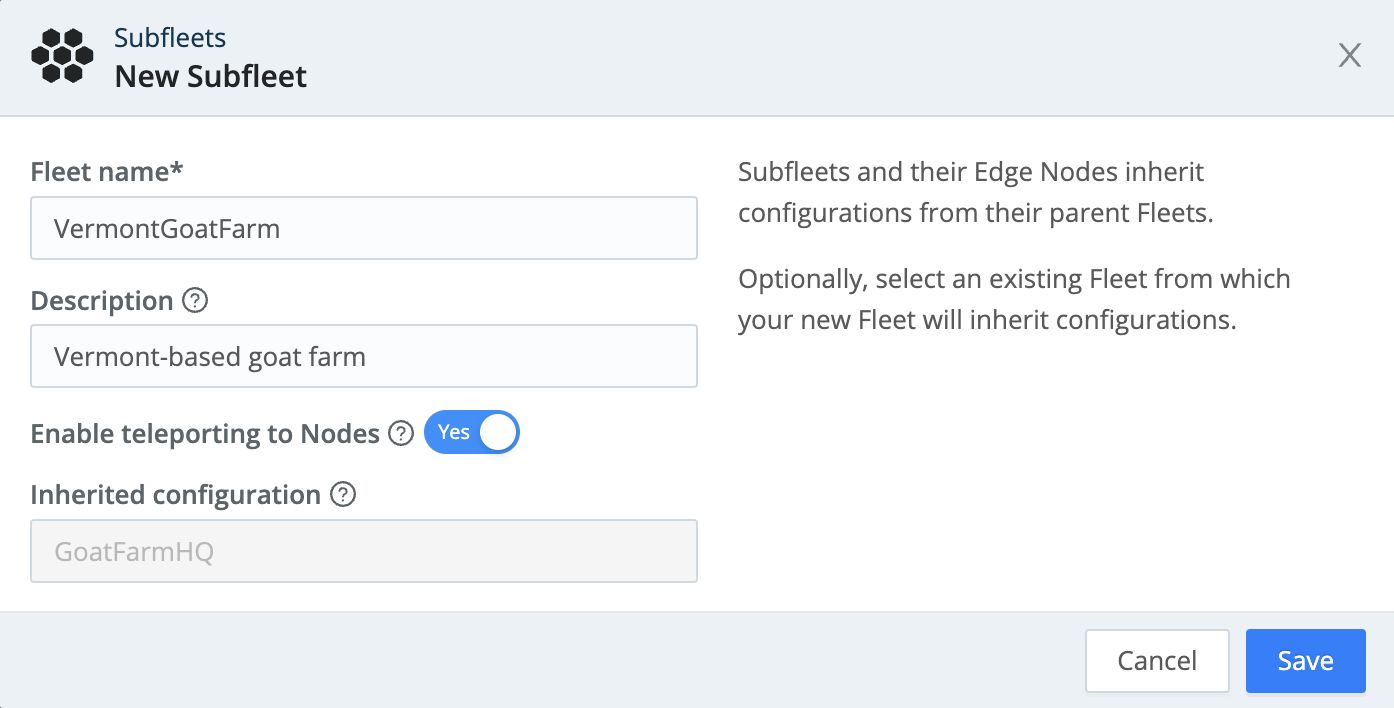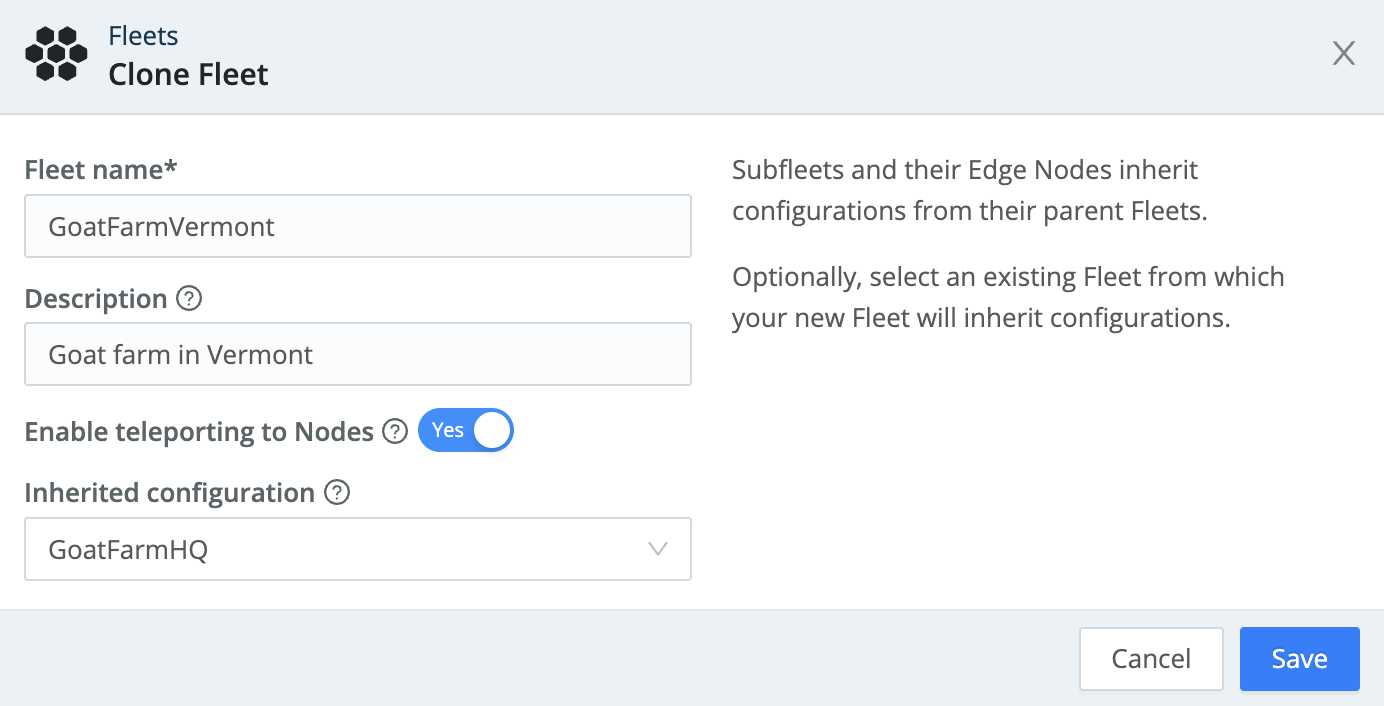These docs are for Cribl Edge 4.9 and are no longer actively maintained.
See the latest version (4.15).
Creating and Managing Fleets and Subfleets
Learn how to create Fleets and Subfleets in Cribl Edge.
Fleets and their corresponding Subfleets allow you to author and manage configuration settings for a particular set of Edge Nodes, so you can flexibly group Edge Nodes into logical Fleets and Subfleets. These Fleets and Subfleets can share and reuse configurations.
In Cribl Edge v.4.2.x and later, you can assign Fleet-level permissions to users. For details, see Members and Permissions.
Create a Fleet
Required permission: Cribl Edge Admin
To create a new Fleet:
- In the sidebar, click Fleets.
- Click New Fleet.
- Enter a descriptive Fleet name, and optionally, a relevant Description and Tags.

To enable teleporting to the Edge Nodes via the Leader’s UI, toggle Enable teleporting to Nodes to Yes, then click Save.
Add a Subfleet
You can create up to four levels of Subfleets nested below a parent Fleet, and choose whether the Subfleet will inherit configurations from its parent Fleet.
To add a Subfleet:
- In the row of your desired Fleet, click Add Subfleet in the Actions column.
- Enter a descriptive Fleet name and optional Description and Tags.
- Select an existing Fleet from the Inherited configuration drop-down. The Subfleet will inherit its configuration from the selected Fleet.
- Click Save.
You can also add a new Subfleet from a parent Fleet by clicking the Add Subfleet button in the Actions column.

Similarly, you can create a Subfleet in a selected Subfleet. You can add up to four levels of Subfleets underneath the parent Fleet, and each Subfleet will inherit the configurations of every parent Subfleet before it.

View Subfleet Details and Options
To display the number of Routes, Pipelines, Sources, and Destinations in a Fleet, click View in the Details column of a Fleet or Subfleet.

On Cribl.Cloud, you’ll also see a Group Type column, showing whether the deployment is Hybrid or Cloud.
To display the Edit Fleet, Configure, Clone,
and Delete options, click the Options (


Clone and Delete a Subfleet
Cloning a Fleet copies the Fleet’s settings, while cloning a Subfleet inherits the parent’s configurations.
To clone a Subfleet, click its Options (


To delete a Fleet or Subfleet, click Delete in the Options (•••) menu. You will be prompted to confirm your decision to delete the Fleet/Subfleet, click Yes to confirm.
You can also commit and deploy changes to Fleets and Subfleets on this page. For details, see Committing and Deploying Fleet Configurations.
Configuring multiple Fleets is available on certain plan/license tiers. For details, see Pricing.
Subfleet Inheritance Configurations
You can organize your Fleets and Subfleets into a hierarchy of configuration layers from the top level down. Subfleets will inherit all the configurations from each parent Fleet that comes before it. At the Fleet level, this might include grouping Edge Nodes with basic configurations like common logging locations, metrics, as well as common Sources and Destinations. At the Subfleet level, you can group Edge Nodes to pick up configurations specific to the applications and services that are running on the Nodes.
There are several strategies you can use to build Fleet hierarchy:
- Organizationally.
- Geographically (if your organization collects different data categories in different regions).
- Data center-based.
- OS-based.
Layering the configurations allows you to manage a large number of Edge Nodes
that share common yet differentiated configurations. For example, as an
administrator, you might need multiple layers of configurations to manage the
following Org > Department > OS > Application. In this case, the Edge Nodes at
the Application level can inherit and share configurations from the Org
level. You can update a parent-level configuration (Fleet) and have it applied
to all Subfleets and their respective Edge Nodes, reducing the time and effort
needed to manage them. For guidance, see our better practices doc: Fleets
Hierarchy and Design.
Access Inherited Packs, Lookups, and Samples
Fleets with inherited configurations can also inherit Packs, Lookups, and Samples. Here’s how to access them:
- Access inherited Packs in More > Data Routes, then open the Pipeline drop-down in a Route. Inherited Packs don’t appear in the Packs list.
- You can teleport into a Node and view Lookups and Samples in their respective lists when you deploy configuration changes to the Edge Nodes.
Save and Manage Certificates
Configure certificates at the Fleet level to securely connect your Cribl Edge to Sources and Destinations. For details, see Setting Authentication on Sources/Destinations.
Subfleets automatically inherit these certificates from their Parent Fleet, streamlining your deployment process. These certificates are then distributed to individual Edge Nodes. Certificates are stored locally on each Edge Node in the local/edge/auth/certs/ directory.
To view and manage certificates, navigate to Fleet Settings > Security > Certificates.
All certificates from both the parent Fleet and Subfleet are visible in the Subfleet’s certificate list.
Edge Node GUID
When you install and first run the software, a GUID is generated and stored in a
.dat file located in CRIBL_HOME/local/cribl/auth/.
For example:
# cat CRIBL_HOME/local/cribl/auth/676f6174733432.dat
{"it":1570724418,"phf":0,"guid":"48f7b21a-0c03-45e0-a699-01e0b7a1e061"}
When deploying Cribl Edge as part of a host image or VM, be sure to remove this file, so that you don’t end up with duplicate GUIDs. The file will be regenerated on the next run.





